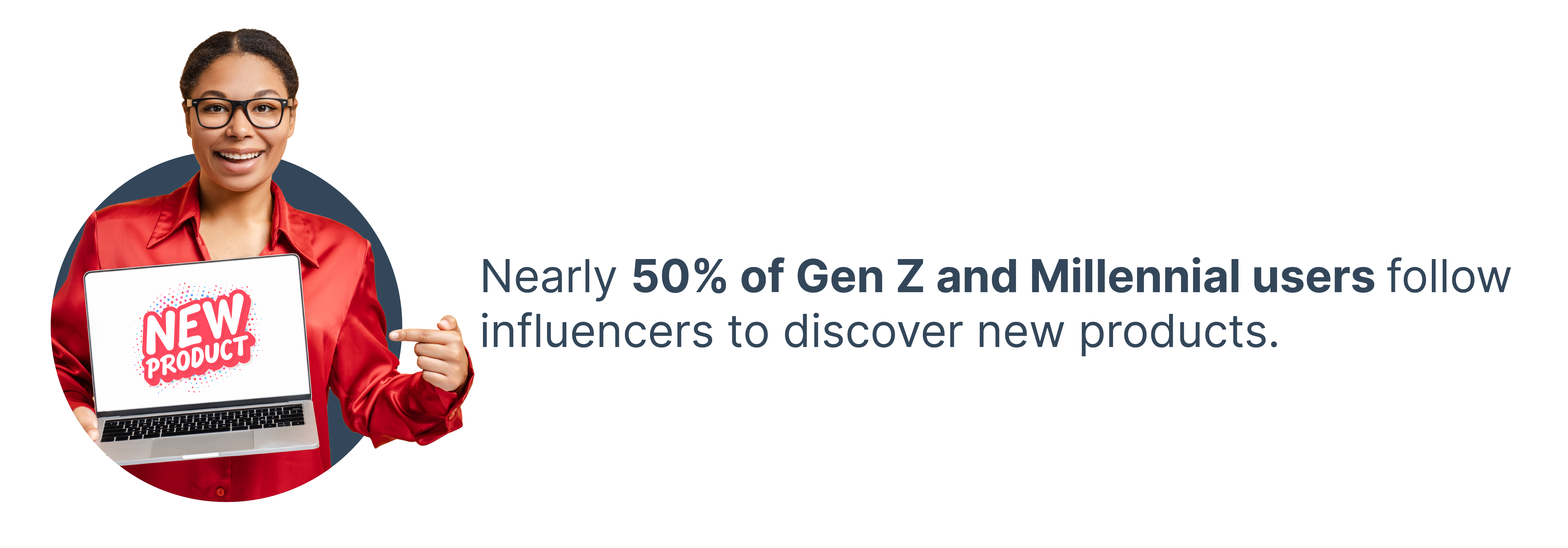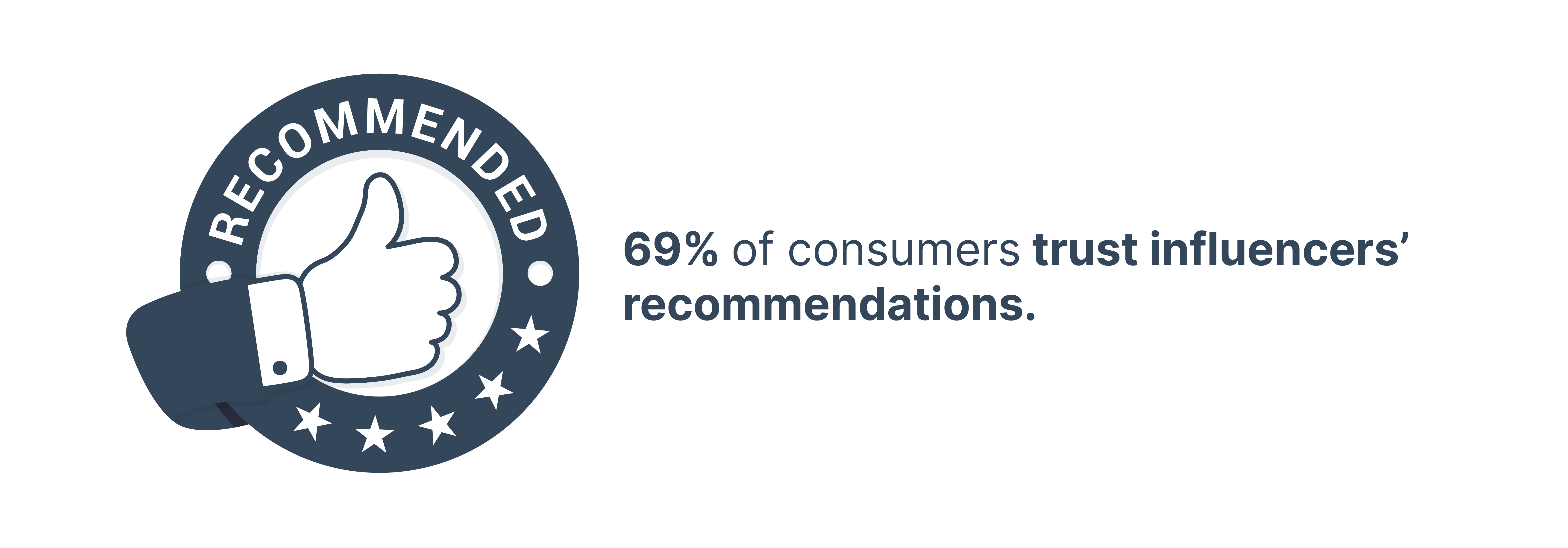What is an Influencer and Are They Right for You?
Leveraging the power of influencer marketing presents unique opportunities for digital marketers. With the rise of social media, influencers have become an integral part of the marketing landscape, offering brands a direct line to targeted audiences through authentic and engaging content.
However, with so many options and varying levels of influence, deciding if influencers are the right fit for your marketing strategy and how to effectively measure their impact can be daunting. In this blog, we'll dive into what an influencer is, the evolution of influencer marketing, and provide insights to help you determine if influencer marketing aligns with your brand’s goals.
What is an influencer?
An influencer is someone who has the power to affect the purchasing decisions of others. Typically, an influencer has built a large and highly engaged following in a particular niche by sharing their insights, experiences, and recommendations on various topics. Influencers use their platforms to promote products, services, or causes and are often seen as trusted sources of recommendations for their followers.
You could think of an influencer as that one popular friend who always knows the best places to eat, the coolest gadgets to buy, and the trendiest fashion to wear. Whenever they recommend something, you listen because you trust their taste and judgment. Just like your friend's advice can influence your choices, influencers impact the buying habits and opinions of their followers.

Source: Shopify
The Rise of Influencer Marketing
While it may seem like a contemporary phenomenon, the idea of influencer marketing goes back to the early 2000s when social media platforms like MySpace and YouTube gained traction. Its significant rise in popularity and mainstream acceptance started around the early 2010s when Instagram and Twitter became hubs for influencers and brands to collaborate on. One notable early influencer, Casey Neistat, emerged on YouTube, showcasing the power of engaging content and a strong online presence in shaping public opinion and consumer behavior. This highlighted the potential for individuals with significant online followings to sway audience decisions and preferences.
As social media platforms evolved, they enabled ordinary people to amass large followings around specific niches, such as beauty, fashion, fitness, and gaming. A prime example of this is Nikki Tutorials, a Dutch makeup artist who launched her YouTube channel in 2008. With a subscriber base now exceeding 14 million, Nikki's journey underscores the emergence and influence of modern influencer marketing, marking a pivotal moment where personal passion met professional endorsement, signalling the birth of modern influencer marketing.
How has influencer marketing affected consumer behaviour?
Influencers provide a more personal, authentic touch to brand endorsements that would not be possible from traditional advertising tactics alone. Consumers, especially Millennials and Gen Z, show a preference for influencer recommendations over conventional advertisements, viewing influencers as relatable and trustworthy sources. This shift has led to influencer marketing becoming an integral part of the marketing mix for companies looking to tap into specific audiences, drastically changing the landscape of advertising and consumer engagement.

Source: Captiv8
Types of influencers
Influencers are typically categorized based on their follower counts and the niches they dominate. This segmentation allows marketers to choose influencers that best align with their campaign goals, and select ones with audiences that would be an ideal target market. Some of the categories of influencers include:
Mega-influencers
Mega-influencers are the giants of the influencer world, boasting millions of followers. These are often celebrities or internet personalities who have achieved widespread fame. Their primary benefit to brands is their vast reach, capable of introducing a product or service to a global audience with a single post. While their engagement rates might be slightly lower compared to influencers with smaller followings, the sheer volume of impressions they generate can be invaluable for brand visibility and awareness campaigns.
Macro-influencers
Macro-influencers occupy the middle ground, with follower counts ranging from hundreds of thousands to a million. They have typically earned their following through consistent, high-quality content in specific fields such as travel, fashion, or fitness. The benefits of partnering with macro-influencers include access to a large but more targeted audience. Their followers are often more engaged and loyal, leading to higher interaction rates, which can be particularly beneficial for brands looking to generate buzz or promote in-depth interaction with their content.
Micro-influencers
Micro-influencers have a much smaller, more dedicated following, usually between a few thousand and 100,000. They are known and trusted more for their authenticity and high levels of engagement. Working with micro-influencers offers brands the advantage of highly engaged audiences that trust and value the influencer's recommendations, leading to higher conversion rates. These influencers often have a close-knit community feel, making their endorsements feel more personal and genuine. This category is ideal for brands seeking to cultivate a loyal customer base and foster genuine conversations around their products or services. They are especially valuable for brands with more limited budgets or those looking to target niche markets with precision.
Ultimately, the decision should be informed by having a thorough understanding of your campaign's specific needs and goals, as well as an analysis of the influencer's audience demographics and engagement patterns. A successful influencer marketing strategy often involves leveraging a mix of influencer types to achieve a balance of reach, engagement, and authenticity.
The challenges of influencer marketing
Navigating the intricate process of selecting the right influencer presents a unique set of challenges. From ensuring value alignment to finding genuine brand advocates, marketers must tread carefully to forge meaningful partnerships. Here's a breakdown of key hurdles and how to approach them:
Finding the right fit
The essence of a successful influencer partnership lies in aligning with someone who genuinely resonates with your brand's values and audience. This requires diligent research and a deep dive into potential influencers' content, engagement rates, and audience demographics. The challenge is not just about numbers but finding a voice that can authentically represent and amplify your brand message.
Navigating authenticity and trust
With the rise of influencer marketing, audience skepticism towards sponsored content has increased. The key challenge is ensuring that collaborations appear as authentic as possible, emphasizing genuine product or service endorsements. This authenticity directly influences audience trust, which is paramount for the effectiveness of your campaign.
Maintaining brand consistency
Ensuring your brand message remains consistent across various influencer collaborations can be tricky. It's crucial to have a comprehensive brief and maintain open lines of communication with your influencers to ensure that all content produced is in harmony with your brand identity.
Measuring ROI
Quantifying the return on investment (ROI) from influencer marketing campaigns can be daunting. The diversity in campaign objectives - from brand awareness to direct sales - requires a multifaceted approach to measurement. Establishing clear KPIs before the campaign launch and utilizing analytics tools like Hurree can help in navigating this challenge.
How to measure the ROI of your influencer marketing strategy
Measuring the ROI of influencer marketing campaigns is pivotal for understanding their impact and justifying future investments in this strategy. However, the diversity of campaign goals - from enhancing brand awareness to driving sales - necessitates a nuanced approach to evaluation. Here are essential steps and metrics to consider:
- Define clear objectives: Begin by establishing what success looks like for your campaign. Is it increased website traffic, higher sales, or more social media followers? Your objectives will dictate the metrics you track.
- Use trackable links: Provide influencers with unique, trackable links for their posts. This enables you to directly measure the traffic, conversions, or sales generated from each influencer's content.
- Monitor engagement rates: Beyond clicks and conversions, engagement (likes, comments, shares) indicates how well the content resonates with the audience. High engagement rates often translate to stronger brand affinity and awareness.
- Leverage analytics tools: Utilize social media and analytics tools to gather data on the performance of influencer content. Many platforms offer insights into reach, impressions, and engagement metrics.
- Calculate ROI: Finally, assess the financial return by comparing the campaign's cost against the value of the outcomes achieved. This might involve sales generated, the value of increased brand exposure, or the estimated worth of user-generated content prompted by the campaign. For a positive ROI, your revenue should exceed your total spend (including ad spend, production costs, and influencer compensation).
Are influencers right for you?
Deciding whether influencers are the right fit for your brand involves a thorough assessment of your marketing objectives and how influencer marketing might align with your overall strategy. Here’s how you can evaluate if this approach suits your brand:
- Clarify your marketing goals: Begin by defining what you hope to achieve with your marketing efforts. Are you looking to increase brand awareness, drive sales, or enhance customer engagement? Influencer marketing can be highly effective for these goals, given its power to reach targeted audiences through trusted voices.
- Understand your audience: Knowing your target audience is crucial. Which platforms do they use most? What kind of content resonates with them? Influencers who already engage with your target demographic can offer a natural and effective way to connect with potential customers.
- Evaluate budget and resources: Consider whether you have the budget to invest in influencer partnerships. While micro-influencers might offer more budget-friendly options, top-tier influencers will require a significant investment. Assess if you have the necessary resources to manage these partnerships effectively.
- Align with brand values: Ensure that potential influencer partners reflect your brand’s values and aesthetics. A mismatch here could lead to inauthentic campaigns that fail to resonate with both your existing and potential customers.
- Measure success: Finally, consider if you’re equipped to measure the success of influencer campaigns against your goals. Effective tracking and analysis are essential to justify the investment and guide future marketing strategies.
If your brand wants to enhance its reach and engagement through authentic storytelling and targeted audience interaction, and you have the means to measure and manage these campaigns, influencer marketing could be a highly beneficial addition to your marketing mix. Understanding the return on investment (ROI), performance metrics, and managing your spend efficiently are foundational steps to ensuring that influencer partnerships are truly benefiting your business. This strategic approach not only optimizes your marketing efforts but also safeguards your investment, ensuring that every pound or dollar spent contributes to your overarching business goals.
For marketers seeking to navigate the complexities of influencer marketing with ease, Hurree offers a robust platform for tracking these essential metrics. With Hurree, you gain a clear view of your campaigns' impact, allowing for data-driven decisions and strategy refinements. Sign up for a free trial of Hurree today, and experience firsthand how it can transform your approach to influencer marketing, making it more transparent, measurable, and, ultimately, more effective.
Share this
You May Also Like
These Related Stories

Top Marketing Trends 2024: Future Insights and Predictions

The Importance of A Strong Brand Image & How To Influence It


